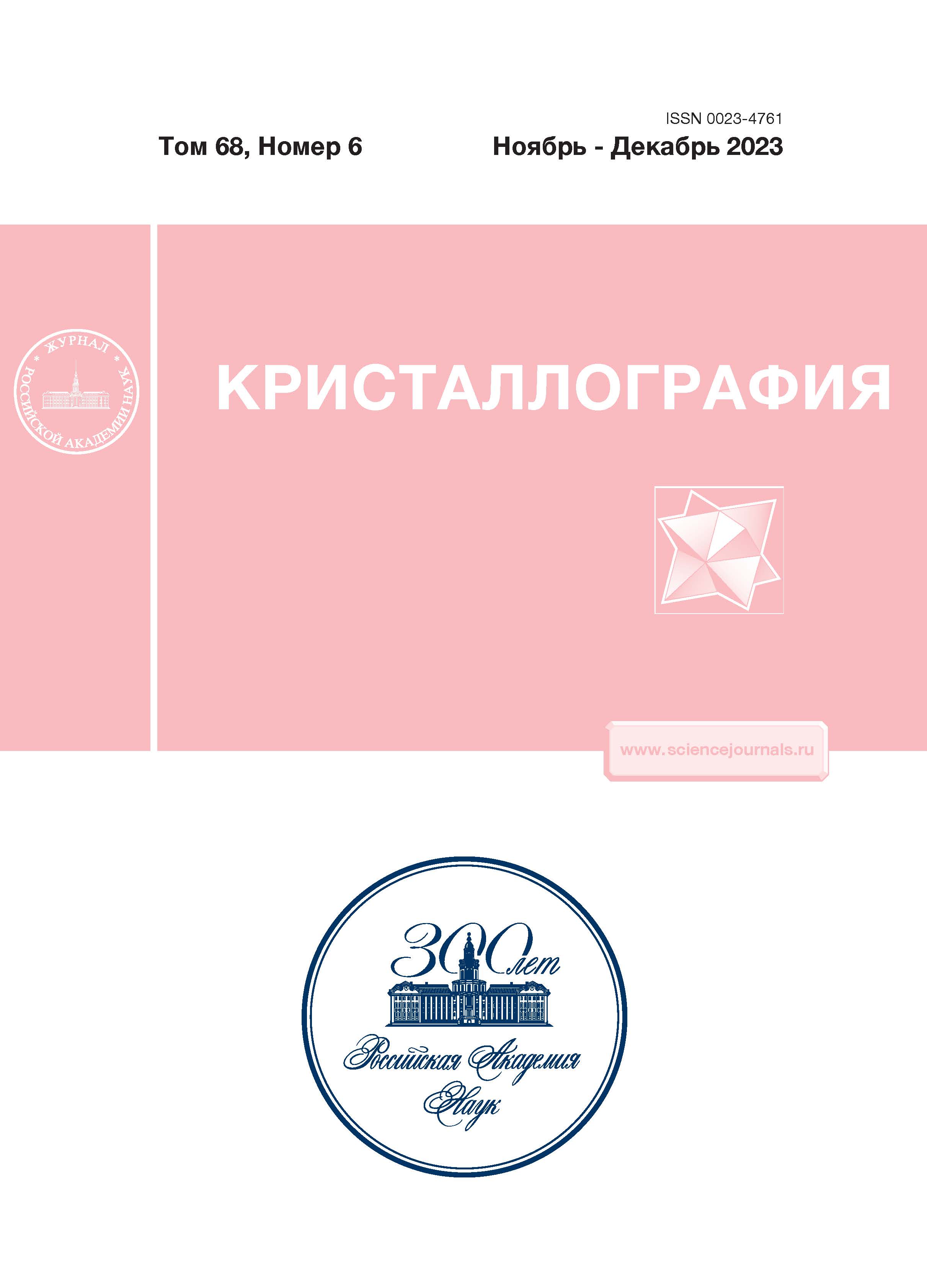The Structure of the Hfq Protein from Chromobacterium haemolyticum Revealed a New Variant of Regulation of RNA Binding with the Protein
- 作者: Lekontseva N.V.1, Nikulin A.D.1
-
隶属关系:
- Institute of Protein Research, Russian Academy of Sciences, Pushchino, Moscow oblast, Russia
- 期: 卷 68, 编号 6 (2023)
- 页面: 907-913
- 栏目: STRUCTURE OF MACROMOLECULAR COMPOUNDS
- URL: https://rjpbr.com/0023-4761/article/view/673284
- DOI: https://doi.org/10.31857/S0023476123700339
- EDN: https://elibrary.ru/FVWDIA
- ID: 673284
如何引用文章
详细
The structure of the Hfq protein from the bacterium Chromobacterium haemolyticum, which forms crystals in two different spatial groups, has been determined. In both cases, the protein has a specific quaternary hexamer-ring structure. The obtained structure showed a previously undescribed interaction between the C-terminal unstructured part of Hfq and the amino acid residues of the proximal RNA-binding site of the protein. This contact may contribute to the regulation of the binding of RNA molecules to the Hfq protein.
作者简介
N. Lekontseva
Institute of Protein Research, Russian Academy of Sciences, Pushchino, Moscow oblast, Russia
Email: nikulin@vega.protres.ru
Россия, Пущино
A. Nikulin
Institute of Protein Research, Russian Academy of Sciences, Pushchino, Moscow oblast, Russia
编辑信件的主要联系方式.
Email: nikulin@vega.protres.ru
Россия, Пущино
参考
- Jørgensen M.G., Pettersen J.S., Kallipolitis B.H. // Biochim. Biophys. Acta – Gene Regul. Mech. 2020. V. 1863. P. 194504. https://doi.org/10.1016/j.bbagrm.2020.194504
- Holmqvist E., Wagner G.H. // Biochem. Soc. Trans. 2017. V. 45. P. 1203. https://doi.org/10.1042/BST20160363
- Dutta T., Srivastava S. // Gene. 2018. V. 656. P. 60. https://doi.org/10.1016/j.gene.2018.02.068
- Wagner E.G.H., Romby P. // Adv. Genet. 2015. V. 90. P. 133. https://doi.org/10.1016/bs.adgen.2015.05.001
- Pecoraro V., Rosina A., Polacek N. // Non-Coding RNA. 2022. V. 8. P. 22. https://doi.org/10.3390/ncrna8020022
- Miyakoshi M. et al. // Mol. Microbiol. 2022. V. 117. P. 160. https://doi.org/10.1111/mmi.14814
- Antoine L. et al. // Genes (Basel). 2021. V. 12. P. 1125. https://doi.org/10.3390/genes12081125
- dos Santos R.F., Arraiano C.M., Andrade J.M. // Curr. Genet. 2019. V. 65. P. 1313. https://doi.org/10.1007/s00294-019-00990-y
- Stenum T.S., Holmqvist E. // Mol. Microbiol. 2022. V. 117. P. 4. https://doi.org/10.1111/mmi.14785
- Katsuya-Gaviria K. et al. // RNA Biol. 2022. V. 19. P. 419. https://doi.org/10.1080/15476286.2022.2048565
- Woodson S.A., Panja S., Santiago-Frangos A. // Microbiol. Spectr. / Ed. Storz G., Papenfort K. 2018. V. 6. https://doi.org/10.1128/microbiolspec.RWR-0026-2018
- Updegrove T.B., Zhang A., Storz G. // Curr. Opin. Microbiol. 2016. V. 30. P. 133. https://doi.org/10.1016/j.mib.2016.02.003
- Murina V., Lekontseva N., Nikulin A. // Acta Cryst. D. 2013. V. 69. P. 1504. https://doi.org/10.1107/S090744491301010X
- Park S. et al. // Elife. 2021. V. 10. P. 1. https://doi.org/10.7554/eLife.64207
- Kavita K., de Mets F., Gottesman S. // Curr. Opin. Microbiol. 2018. V. 42. P. 53. https://doi.org/10.1016/j.mib.2017.10.014
- Schu D.J. et al. // EMBO J. 2015. V. 34. P. 2557. https://doi.org/10.15252/embj.201591569
- Santiago-Frangos A. et al. // Proc. Natl. Acad. Sci. U. S. A. 2019. V. 166. P. 10978. https://doi.org/10.1073/pnas.1814428116
- Kavita K. et al. // Nucl. Acids Res. 2022. V. 50. P. 1718. https://doi.org/10.1093/nar/gkac017
- Santiago-Frangos A. et al. // Proc. Natl. Acad. Sci. U. S. A. 2016. V. 113. P. E6089. https://doi.org/10.1073/pnas.1613053113
- Han X.Y., Han F.S., Segal J. // Int. J. Syst. Evol. Microbiol. 2008. V. 58. P. 1398. https://doi.org/10.1099/ijs.0.64681-0
- Lima-Bittencourt C.I. et al. // BMC Microbiol. 2007. V. 7. P. 58. https://doi.org/10.1186/1471-2180-7-58
- Takenaka R. et al. // Jpn. J. Infect. Dis. 2015. V. 68. P. 526. https://doi.org/10.7883/yoken.JJID.2014.285
- Okada M. et al. // BMC Infect. Dis. 2013. V. 13. P. 406. https://doi.org/10.1186/1471-2334-13-406
- Tanpowpong P., Charoenmuang R., Apiwattanakul N. // Pediatr. Int. 2014. V. 56. P. 615. https://doi.org/10.1111/ped.12301
- Teixeira P. et al. // Mol. Genet. Genomics. 2020. V. 295. P. 1001. https://doi.org/10.1007/S00438-020-01676-8
- Winn M.D. et al. // Acta Cryst. D. 2011. V. 67. P. 235. https://doi.org/10.1107/S0907444910045749
- McCoy A.J. et al. // J. Appl. Cryst. 2007. V. 40. P. 658. https://doi.org/10.1107/S0021889807021206
- Afonine P. V et al. // Acta Cryst. D. 2012. V. 68. P. 352. https://doi.org/10.1107/S0907444912001308
- Emsley P. et al. // Acta Cryst. D. 2010. V. 66. P. 486. https://doi.org/10.1107/S0907444910007493
- Wang W. et al. // Genes Dev. 2011. V. 25. P. 2106. https://doi.org/10.1101/gad.16746011.2004
- Santiago-Frangos A., Woodson S.A. // Wiley Interdiscip. Rev. RNA. 2018. V. 9. P. e1475. https://doi.org/10.1002/wrna.1475
- Sonnleitner E. et al. // Biochem. Biophys. Res. Commun. 2004. V. 323. P. 1017. https://doi.org/10.1016/j.bbrc.2004.08.190
- Vecerek B. et al. // Nucl. Acids Res. 2008. V. 36. P. 133. https://doi.org/10.1093/nar/gkm985
- Panja S. et al. // J. Mol. Biol. 2015. V. 427. P. 3491. https://doi.org/10.1016/j.jmb.2015.07.010












